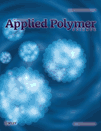Effect of compatibilizer and fillers on the properties of injection molded lignin-based hybrid green composites
Abstract
Composites were prepared from poly(butylene succinate) (PBS), lignin, and switchgrass using extrusion followed by injection molding techniques. The effects of the fillers (lignin and switchgrass) and polymeric methylene diphenyl diisocyanate (PMDI) compatibilizer on the physicomechanical and thermal properties of the composites were investigated. Use of hybrid filler (1 : 1 lignin : switchgrass) resulted in slight improvement in the flexural strength of the composites. Incorporation of 1% PMDI into the hybrid filler reinforced composites significantly enhanced properties compared with the neat PBS which accounts for improvements in the flexural strength, flexural modulus, and heat deflection temperature (HDT) by nearly 165%, 375%, and by 24°C respectively. Lignin exhibited some effects on the thermal properties of composites. However, switchgrass demonstrated a minor effect on the thermal behavior of the composites compared with the lignin. An improved interface was observed from the scanning electron microscopy (SEM) of the compatibilized hybrid composites. © 2012 Wiley Periodicals, Inc. J. Appl. Polym. Sci., 2013




